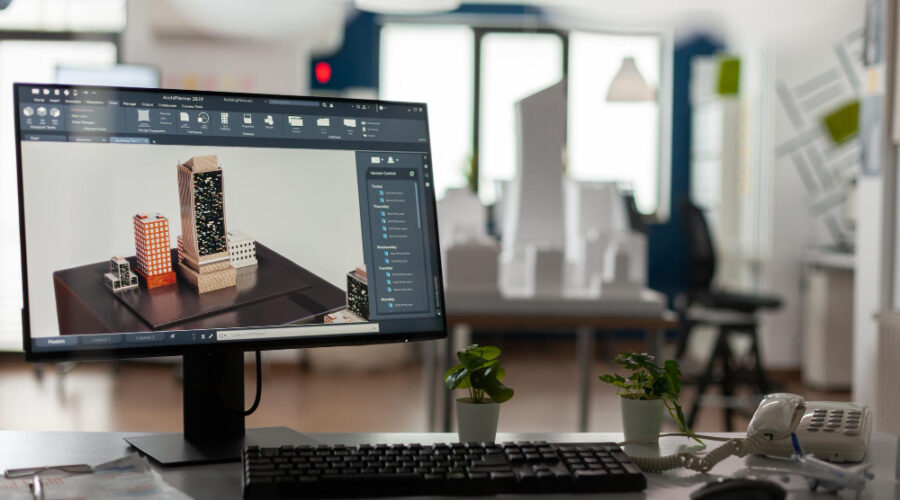Introduction In today's digital age, businesses are constantly seeking innovative ways to reach their target…

The Importance of BIM software in construction modelling
Technology has changed the face of the construction industry. The latter has significantly benefited from improved visualisation and accuracy in construction modelling technology. The ability to build lifelike designs with 3D models is nothing short of miraculous. There’s a revolutionary change in the way we think of utilising space and how we execute projects. The Building Information Modelling (BIM) software has emerged as the most important tool in this regard. Providing a digital representation of a building’s physical and functional characteristics has allowed us to implement bigger and better project ideas.
A construction project is not the brainchild of a single person. There are multiple stakeholders involved starting from architects and project managers to civil engineers and clients. There are several details and specifications involved in every stage of the project This article explores the significance of BIM software in construction modelling and delves into the vital role of fabrication drawing in the construction process.
What is BIM?
The acronym stands for Building Information Modelling (BIM). It is a software that helps you plan and design a 3D model to create an infrastructure project and its building components. The model is used by architects, engineers, project managers and clients to analyse various dimensions of the building, make adequate changes, and give innovative inputs to make the optimum use of space and resources. A BIM model sheds light on different aspects of the building such as the use of materials involved and the financial and logistical information. It presents a holistic picture of the entire project in a single place and the data gathered in the software can then be shared and used judiciously among the stakeholders to execute the project perfectly.
Significance of BIM
A lot of thought and preparation goes behind the planning of a construction project before the first brick is even laid. Each and every aspect of the building is to be visualised and given concrete shape in the form of a fabrication drawing. Earlier, 2D designs were relied upon but the advent of BIM has given us the flexibility to create three-dimensional models in building design. The software holds immense significance due to the following reasons.
- Enhanced Visualisation: BIM software allows construction professionals to create detailed 3D models of buildings, infrastructure, and various components. This enhanced visualisation helps stakeholders including architects, engineers, and clients, to gain a comprehensive understanding of the project’s design and functionality.
- Improved collaboration: BIM fosters collaboration among project teams by providing a centralised platform for sharing and updating project data. This reduces miscommunication and ensures that all parties work from the same set of information, leading to fewer errors and improved project outcomes.
- Efficient Design and Analysis: BIM software offers tools for simulating and analysing different aspects of a construction project. These include structural integrity, energy efficiency, and spatial optimization. This enables designers to make informed decisions early in the design process, reducing the need for costly revisions later on.
- Cost Savings: By streamlining the design and construction processes, BIM helps control costs. It allows for better cost estimation, budget tracking, and resource allocation, ultimately leading to more accurate project budgeting and reduced financial risks.
- Sustainability: BIM software enables architects and engineers to assess the environmental impact of a building design. This promotes the integration of sustainable practices, such as energy-efficient systems and materials, into construction projects.
Applications of Fabrication Drawings
A fabrication drawing is a critical component of the construction process, especially in scenarios where precise components need to be manufactured or assembled. Here are some key uses and applications of fabrication drawings:
- Customization: These drawings provide detailed instructions for creating custom components, such as structural steel members, windows, or specialised machinery parts. They ensure that these components are manufactured to the exact specifications required for a project.
- Quality Assurance: These drawings serve as a reference for quality control during the manufacturing process. They help verify that the fabricated components meet the design and engineering standards, reducing the risk of defects or failures.
- Material Optimisation: These drawings often include information about material specifications, helping manufacturers optimise material usage and minimise waste. This is especially important for cost-conscious projects and sustainability goals.
- Installation Guidance: These drawings can include assembly instructions and details, aiding in the on-site installation of prefabricated components. This ensures that the components fit together seamlessly and align with the project’s design.
- Documentation: These drawings serve as a valuable documentation tool, providing a historical record of the components used in a project. This documentation can be invaluable for maintenance and future renovations.
Conclusion
Building Information Modeling (BIM) software has become indispensable for its ability to improve project visualisation and construction modelling. It has significantly improved collaboration, design efficiency, cost management, and sustainability. Alongside BIM, fabrication drawings play a crucial role in ensuring the precise manufacturing and assembly of custom components, contributing to the overall success of construction projects. If you’re looking to implement a greenfield project and are in search of a construction consultancy firm experienced in BIM and associated construction design, Edanbrook offers you the most innovative solutions.




This Post Has 0 Comments